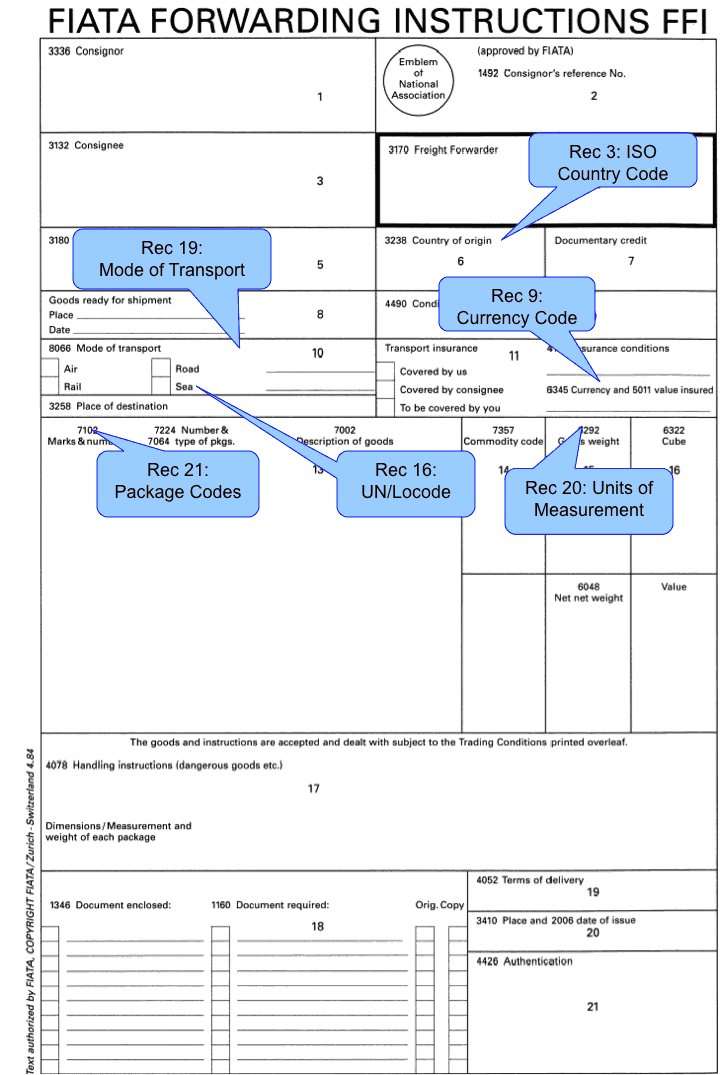Code Lists
Code Lists are list of codes to be used in documents in order to constrain input and avoid errors. When filling in forms, instead of keying in free text, a code list will constrain the accepted entry. This is an essential part of document alignment and data harmonisation process for business or government messages. Many of the standard code lists in use today were developed for EDIFACT messages and are published by UN/CEFACT and ISO.
Problem
Many documents used in international trade, such as the invoice or the customs declaration, require information on locations, currency, dates, measurements and other elements. This information is however often spelled differently in many countries and languages. Hence, the information is ambiguous and may be misunderstood, or can not be processed by electronic systems.
Solution
In order to represent this information in an unambiguous ways, this information can be coded. The code than becomes a unique and unambiguous way of representing information, in paper format as well as electronic exchange. The document or forms designer should require the use of codes that are used internationally, such as according to UNECE Recommendations listed below, including the UN/LOCODE, Incoterms, etc.
Example
Below is a model FIATA Forwarding instruction form. It indicates the locations on the document where code lists are used.

Benefits
Code Lists ensure errors are minimized, such as misspellings, misunderstandings and ambiguity. Code lists are published as part of a standards and recommendations process and are essential to the interoperability of messages.
The code lists below are part of UNECE and UNCEFACT Recommendations;
| No. | Standard Reference | Name | Description |
| 3 | 3166 | Country Code | A list of country codes |
| 5 | Incoterms 2000 | Inconterms | Recommends the use of the INCOTERMS, developed by International Chambers of Commerce (ICC), whenever these terms are referred to in abbreviate form |
| 7 | Numerical Representation of Dates, Time and Periods of Time | Method for a standardized and unambiguous all-numerical designation of a given Date, time of data and period of time | |
| 9 | 4217 | Currency Code | A list of currency codes |
| 15 | < | Simpler Shipping Marks | Standard consignment identifier in the form of a simplified and standardized shipping mark, for marking on packages and for reproduction in documents. |
| 16 | UN/LOCODE; Code for Ports and other locations | Five letter alphabetic code for abbreviating the names of locations of interest to international trade, such as port, supports, inland freight terminals, and other locations where Customs clearance of goods can take place | |
| 19 | Modes of Transport | One-digit numerical code for representing transport modes , second digit for sub.divisions wherever the information is represented in coded form. | |
| 20 | Unit of Measure | Three character alphabetic and alphanumeric codes for representing units of measurements for length, area, volume/capacity, mass (weight), time, and other quantities used in international trade. Based on Systems International Units (SI) | |
| 23 | Freight Cost Codes | Naming system to be used for the establishment o harmonized descriptions of freight costs and other charges related to the international movement of goods. | |
| 24 | Trade and Transport Status Codes | Codes to satisfy requirements for exchanging coded information about the status of consignments, goods or means of transport at a certain time or place in the transport chain | |
| 28 | Transport Means | Common code list for the identification of the type of means of transport |

